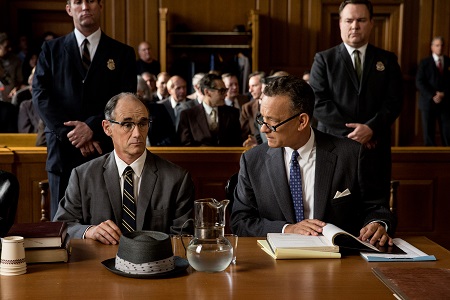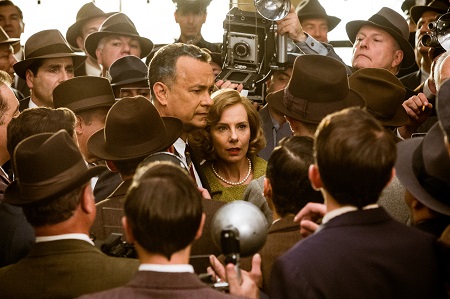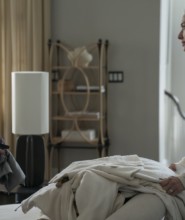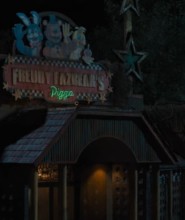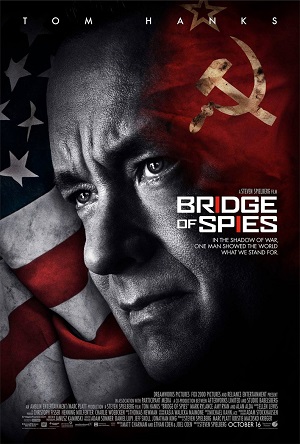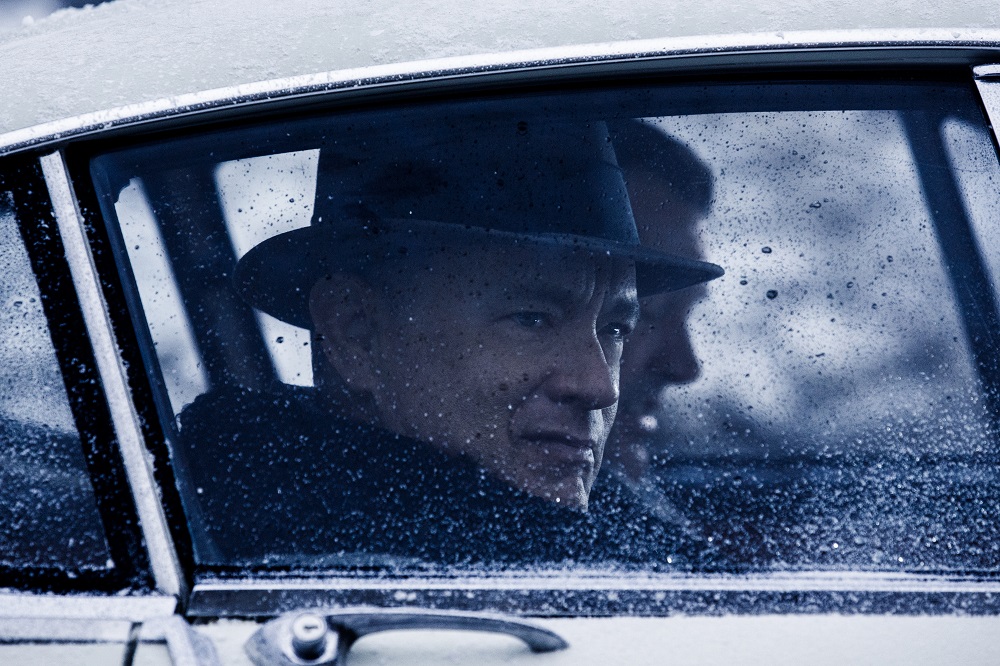
Effectively Sparse Spies an Engaging Cold War Thriller
With the Cold War raging, the FBI has arrested Rudolf Abel (Mark Rylance) as a Russian spy. Wanting to show the world that American justice is equal for everyone no matter what the crime, the Justice Department, with the assistance of his fatherly boss Thomas Waters, Jr. (Alan Alda), urges esteemed Brooklyn lawyer James B. Donovan (Tom Hanks) to defend the accused to the best of his abilities. While his wife Mary (Amy Ryan) would rather he’d decline, the patriotic jurist sees it as his duty to take on the case, realizing that by doing so he’ll likely become the second most hated man in the country, the first being the client he’s now agreed to represent.
Understanding just how great a service he has done for his country, after the trial has come to an end and the appeals process has been exhausted, the State Department has a new task for Donovan, one they are certain he is the most suitable candidate to take on. There has been an international incident in Russia, a CIA plane crashing to earth, its pilot Francis Gary Powers (Austin Stowell) being held as a spy. The government would like the lawyer to go to East Berlin and negotiate for his release, not as his country’s representative but as a lawyer still trying to speak for his client even after the battle has ostensibly been lost. They want Donovan to trade Rudolf Abel for Francis Gary Powers, and they want him to do it before the Air Force pilot gives into interrogation and reveals secrets the CIA would rather stay unspoken.
Inspired by real events, Steven Spielberg’s Bridge of Spies is a handsomely mounted, remarkably entertaining procedural that’s as compelling as it is informative. While not quite soaring to the same, instantly classic heights as the filmmaker’s last historical endeavor, Lincoln, this is without a doubt one of the storied director’s best films in over a decade, at least since the double-whammy of Minority Report and Catch Me If You Can, probably since his criminally underrated A.I.: Artificial Intelligence. It is an invigorating, old school drama made with the same care and attention to detail Stanley Kramer brought to films like Judgment at Nuremburg, Inherit the Wind and The Defiant Ones, showing a measured touch that in many ways is extraordinary.
Not that the film isn’t without its idiosyncratic quirks. Working from a script by Matt Charman (Suite Française) and, most notably, brothers Joel and Ethan Coen (True Grit, Raising Arizona), there is an absurdist, slyly comedic thread dangling throughout, one that energizes scenes and moments in oftentimes startling ways. The conversations between Donovan and Abel are particularly captivating, the level of understanding that grows between the two men ingeniously coupled with a knowing acid-laced comprehension that the incidents they are involved in have little to do with law and order and almost everything to do with political gamesmanships between competing nations.
Hanks is in stoic, all-American everyman mode, channeling his inner Gregory Peck or Henry Fonda in order to bring Donovan to life. Yet the performance is still sensational, filled with little beats and moments that help shade the whip-smart lawyer in ways that amaze. Whether he’s going one-on-one with Rylance or verbally dueling with The Lives of Others star Sebastian Koch (as an East German lawyer determined to get a deal for his country that would put them on par with the U.S. and Russia) over the life of another captured American, collegiate graduate student Frederic Pryor (Will Rogers), the two-time Academy Award-winner is at his best, crafting a portrait of resilience, creativity and intelligence that’s fascinating.
It is Rylance, however, who steals things. The veteran character actor, known for a variety of roles in projects as varied as “Wolf Hall,” Anonymous, The Other Boleyn Girl and Angels and Insects, gives one of the year’s best performances, exuding a quiet, knowing awareness that ends up befitting Abel magnificently. He dominates every moment he’s a part of even if he doesn’t utter a line, the way he sits on the corner of a bed smoking a crumpled up cigarette speaking volumes. His observations as to what is happening and why offer up a form of clarity that does not exist until he puts words to them, Rylance finding a way to give his cagey, world-weary spy a knowing electricity that allows for his presence to be felt even if he’s justifiably sidelined for the majority of the film’s second half.
Unsurprisingly, on the technical front the movie is aces across the board. Veteran Spielberg contributors cinematographers Janusz Kaminski (Schindler’s List) and editor Michael Kahn (Close Encounters of the Third Kind) are each at the top of their respective games, while new collaborators costume designer Kasia Walicka-Maimone (Moonrise Kingdom) and production designer Adam Stockhausen (The Grand Budapest Hotel) do a spectacular job helping the director give this Cold War world life. Only composer Thomas Newman (Side Effects) comes up short, his music never achieving liftoff, the music instead sounding as if he’s attempting his best John Williams imitation instead of allowing his own Oscar-winning instincts to lead him in a personal, and likely more effective, direction.
There are a handful of other, relatively minor annoyances, not the least of which is the way the script hangs Ryan’s loving wife out to dry with precious little to do other than pine for the safety of her husband, but in the end these do not matter nearly as much as they could have in lesser hands. Spielberg is in fine form with Bridge of Spies, his handling of the material confidently self-assured and magnetic. A stunning procedural, this is an intimate, engagingly personal thriller that held me spellbound first moment to last, building to a suitably tense climax upon the film’s titular location that’s as appropriate as it is divine.
Film Rating: 3½ (out of 4)

